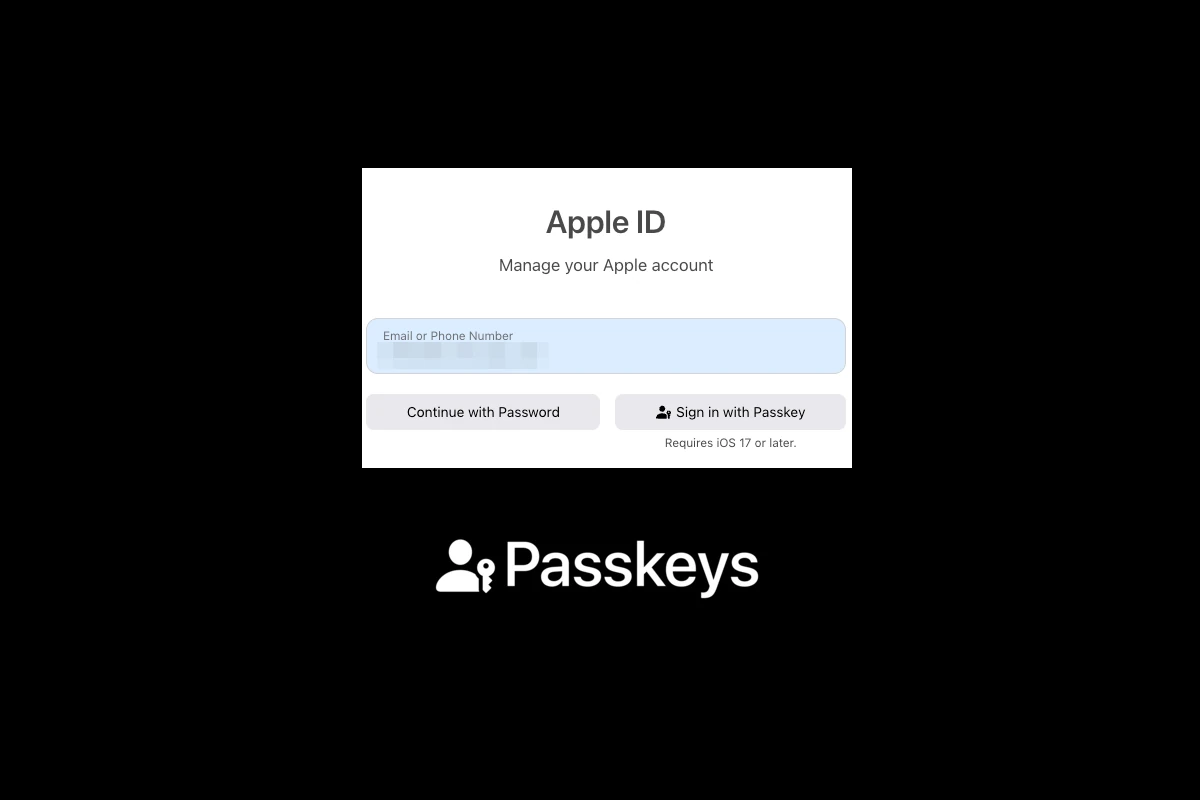Apple has introduced a new feature called passkey, aimed at making it easier and safer to sign in to apps and websites. With this feature, users can use Face ID or Touch ID instead of typing passwords. Passkeys are unique codes specific to your devices, offering better security compared to traditional passwords. This innovative authentication method is known as Apple Sign In with Passkey.
It eliminates the need for regular passwords, providing a more secure and convenient alternative. Passkeys are now available for Apple IDs on iOS 17, iPadOS 17, and macOS Sonoma, allowing users to sign in using just a face scan or fingerprint. Additionally, it is fast, simple, and works across all Apple devices using the same Apple ID. If your Mac doesn’t have Face ID or Touch ID, you can use your iPhone to scan a QR code for sign-in.

Apple’s Passkey: A New Era of Secure Sign-In
Apple Passkeys are here, revolutionizing how we log into apps and websites. They’re not just another password replacement; they’re a leap forward in security. Passkeys are more resistant to phishing, stronger than traditional passwords, and designed without shared secrets, making them virtually impenetrable to hackers.

How Do Apple Passkeys Work?
Passkeys leverage the WebAuthentication standard (WebAuthn), utilizing public key cryptography. When you register for an account, your device creates a unique pair of cryptographic keys – a public key stored on the server and a private key that remains on your device. The server never sees your private key, enhancing security.
On Apple devices equipped with Touch ID or Face ID, these biometric features authorize the use of the passkey, seamlessly authenticating you without transmitting any shared secret. This eliminates the risk of password leaks or phishing attacks.

Seamless Synchronization Across Devices
Passkeys aren’t confined to a single device. They sync effortlessly across your Apple devices through iCloud Keychain. This end-to-end encrypted service ensures your passkeys are protected even if your Apple ID account is compromised or iCloud experiences an external attack.
Enhanced Protection for Your Apple ID Account
To safeguard against unauthorized access, Apple has implemented a two-factor authentication requirement for all Apple IDs using iCloud Keychain. If you attempt to register a new passkey without two-factor authentication, you’ll be prompted to set it up, adding an extra layer of security to your account.
Recovery Made Easy, Even if You Lose All Your Devices
Losing all your devices doesn’t mean losing your passkeys. Apple’s iCloud keychain escrow service allows you to recover your passkeys securely, even if Apple doesn’t have access to your passwords or other sensitive data. To recover a keychain, you need to authenticate with your iCloud account and password and respond to an SMS sent to your registered phone number.
Apple Passkeys: Your Key to a More Secure Digital World
Apple Passkeys represent a significant advancement in online security. They’re not only more secure but also more convenient and user-friendly than traditional passwords. With features like seamless synchronization, enhanced account protection, and robust recovery mechanisms, Apple Passkeys are paving the way for a safer and more accessible digital experience.

Benefits of Apple Passkeys:
| Feature | Benefit |
|---|---|
| Phishing Resistant | Eliminates the risk of password leaks or phishing attacks. |
| Stronger Than Passwords | Unique key pairs for each account enhance security. |
| No Shared Secrets | The server never sees your private key, adding another layer of protection. |
| Seamless Synchronization | Access your passkeys across all your Apple devices. |
| Enhanced Account Protection | Two-factor authentication for Apple IDs using iCloud Keychain. |
| Robust Recovery Mechanism | Recover your passkeys even if you lose all your devices. |
Apple’s Passkeys represent a paradigm shift in user authentication. They promise a future where online security is not just robust but also user-friendly, setting a new standard for the industry.
Key Takeaways
- Passkeys replace passwords with Face ID or Touch ID for safer logins
- Apple IDs now support passkeys on new iOS, iPadOS, and macOS versions
- Using passkeys is simple and works across all your Apple devices
Understanding Passkeys
Passkeys offer a new way to sign in to apps and websites. They use your device’s security features instead of passwords. This makes logging in easier and safer.
The Technology Behind Passkeys
Passkeys use cryptography to protect your accounts. They work with Touch ID, Face ID, or a passcode on Apple devices. When you set up a passkey, your device makes a unique key pair. One key stays on your device. The other goes to the app or website.
To sign in, you just use your fingerprint, face, or code. Your device checks if it matches. Then it sends a signal to the app or site. This proves it’s really you without sending any secret info.
Passkeys are safer than passwords. They can’t be guessed or stolen like passwords can. They also sync across your Apple devices using iCloud Keychain.

Integrating Passkeys
Many big websites now let you use passkeys. These include Google, Amazon, and Microsoft. To start using passkeys, update your device’s software. Then turn on iCloud Keychain in your settings.
When you make an account or sign in, look for a passkey option. Your device will guide you through setup. After that, you can sign in with just a touch or look.
Passkeys work on iPhones, iPads, and Macs. They even let you sign in on other devices. If you’re using a public computer, you can use your iPhone to sign in to websites there.
Apple is making passkeys even easier. Soon, your Apple ID will use a passkey by default. This means simpler, safer logins across all your Apple services.

Setting Up and Using Passkeys
Passkeys offer a simple and secure way to sign in to accounts without passwords. They use your device’s built-in security features for easy access.
Creating a New Account with Passkeys
To make a new account with passkeys, go to the sign-up page. Enter your email or username. Pick “Create Account with Passkey” if you see it. Your device will ask you to use Face ID or Touch ID. Once you confirm, your passkey is set up.
This process works on iPhones iPads and Macs. It’s faster than making a password. Plus it’s safer since each passkey is unique to the site and your device.
Managing Passkeys Across Devices
Passkeys sync across your Apple devices through iCloud Keychain. This means you can use them on your iPhone iPad and Mac. To check your passkeys:
- On iPhone or iPad: Go to Settings > Passwords
- On Mac: Open System Settings > Passwords
Here you can view edit or delete passkeys. If you get a new device sign in with your Apple ID. Your passkeys will move over.
Advanced Security
Passkeys boost your online safety. They can’t be guessed or leaked like passwords. Each passkey is tied to one website or app. This stops phishing attacks.
For extra protection use two-factor auth with passkeys. This adds a second check when you sign in. You might get a code on your phone or use an auth app.
If you lose your device don’t worry. Your passkeys are safe in iCloud. Just sign in on a new device to get them back.







